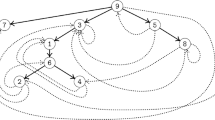Abstract
In the last few decades, several techniques to randomly generate a deterministic finite automaton have been developed. These techniques have implications in the enumeration and random generation of automata of size n. One of the ways to generate a finite automaton is to generate a random tree and to complete it to a deterministic finite automaton, assuming that the tree will be the automaton’s breadth-first spanning tree. In this paper we explore further this method, and the string representation of a tree, and use it to counting the number of automata having a tree as a breadth-first spanning subtrees. We introduce the notions of characteristic and difference sequence of a tree, and define the weight of a tree. We also present a recursive formula for this quantity in terms of the “derivative” of a tree. Finally, we analyze the implications of this formula in terms of exploring trees with the largest and smallest number of automata in the span of the tree and present simple applications for finding densities of subsets of DFAs.



Similar content being viewed by others
References
Almeida M, Moreira N, Reis R (2007) Enumeration and generation with a string automata representation. Theor Comput Sci 387(2):93–102
Babaali P (2007) Generic and structural properties of random automata. PhD thesis, Stevens Institute of Technology
Babaali P, Knaplund C (2013) On the construction of a family of automata that are generically non-minimal. In: Proceedings of the 7th international conference on languages and automata theory and applications 2013. LNCS, pp 80–91
Bassino F, Nicaud C (2006) Accessible and deterministic automata: enumeration and Boltzmann samplers. In: International colloquium on mathematics and computer science 2006. Discrete mathematics and theoretical computer science proceedings, vol AG, pp 151–160
Bassino F, Nicaud C (2007) Enumeration and random generation of accessible automata. Theor Comput Sci 381(1–3):86–104
Champarnaud J-M, Paranthoën T (2005) Random generation of DFAs. Theor Comput Sci 330:221–235
Domaratzki M, Kisman D, Shallit J (2002) On the number of distinct languages accepted by finite automata with n states. J Autom Lang Comb 7(4):469–486
Flajolet P, Zimmermann P, Van Cutsem B (1994) A calculus for the random generation of labelled combinatorial structures. Theor Comput Sci 132:1–35
Harary F, Palmer EM (1973) Graphical enumeration. Academic Press, New York
Harrison MA (1964) A census of finite automata. In: Proceedings of the fifth annual symposium on switching circuit theory and logical design, pp 44–46
Korshunov AD (1986) On the number of non-isomorphic strongly connected finite automata. J Inf Process Cybern 22:459–462
Mäkinen E (1999) Generating random binary trees, a survey. Inf Sci, Int J 115(1–4):123–136
Nicaud C (2000) Étude du compartement en moyenne des automates finis et des langages rationnels. PhD thesis, University Paris 7
Nijenhuis A, Wilf HS (1978) Combinatorial algorithms: for computers and calculators. Academic Press, San Diego
Robinson RW (1985) Counting strongly connected finite automata. Wiley, New York
Author information
Authors and Affiliations
Corresponding author
Rights and permissions
About this article
Cite this article
Babaali, P., Carta-Gerardino, E. & Knaplund, C. The number of DFAs for a given spanning tree. J Supercomput 65, 710–722 (2013). https://doi.org/10.1007/s11227-013-0957-0
Published:
Issue Date:
DOI: https://doi.org/10.1007/s11227-013-0957-0




